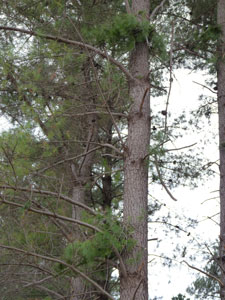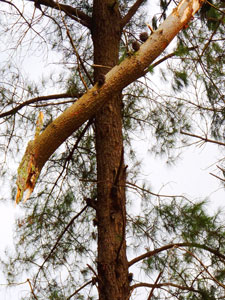
|

|
Conduct Feller Buncher Operations
Unit FPIHAR3207B:
Conduct Feller Buncher Operations
 Forest Operations > Conduct Feller Buncher Operations > Felling Trees With The Feller Buncher
Forest Operations > Conduct Feller Buncher Operations > Felling Trees With The Feller Buncher
Felling Trees With The Feller Buncher
Forest Thinning
Assessing the stand of trees
Before starting to fell trees it is important to walk through the forest and assess the trees and terrain.
Often a contractor or foreman will complete a general assessment as part of the operational planning and hazard identification.
Any issues with the felling operation should be pointed out to the machine operator.
Assess limbs on the break trees; and for any over head hazards
 |
 |
| Fig 1a Pine tree with difficult large limbs. | Fig 1b Large over heads hazard. |
In assessing the stand, the following issues should be considered:
- Tree quality and lean;
- Access for the felling machine;
- Weather patterns particularly wind;
- Road and landing locations, the location of stand boundaries;
- Any protected areas within the stand (e.g. historic or heritage sites);
- Placing trees correctly for extraction direction is very important;
- Areas that need to be left for manual chainsaw felling because of slope, tree size or form, or restricted access;
- Trees must be placed in the correct position for either mechanical processing or skidding. Note these two operations are vastly different;
- Terrain conditions including steep slopes, waterways, depressions or ridges that do not appear on any maps.
A forest should be assessed and documented in the coupe plan; including how the block should be opened up and how the felling and extraction operations will progress through the block to ensure safety and consistency of wood-flow.
Assessing the tree
Before starting to cut each tree, you should assess it to determine:
- If there are any ground or overhead hazards;
- Any malformation or sweep that may influence the felling process;
- Its natural direction of fall (based on wind direction, its lean, and crown weight distribution);
- The best machine position;
- How easy it will be to direct where you want the tree to fall.
Note: You generally have only a restricted view of the top of the next tree to be felled.
This can make viewing overhead hazards difficult when opening up a felling face.
Where possible the operator can look for overhead hazards when walking the machine back to the start of the next strip.
Dealing with trees beyond the machine’s capability
Trees that are too big for the machine to handle and / or trees located on slopes that are beyond the safe working limit for the machine should be left for chainsaw felling.
Clearing the base of the tree
Before felling large trees, you may need to clear around the base of the tree to see if there is any butt sweep or damage that may affect the felling.
You may use the felling head to clear slash and debris away from the base of the tree. This can be done by either crushing it, or using the head to sweep sideways clearing away fallen branches or debris from the base of the tree.
This will allow you to:
- Identify butt malformation and hazards that may obstruct or damage the cutting unit;
- Position the head as low as possible, thereby reducing stump height;
- Judge the placement of the cut to ensure it is correct and completed with efficiency.
You must be visually aware of any solid objects at the base of the tree as they can cause expensive damage and down time to the machine.

